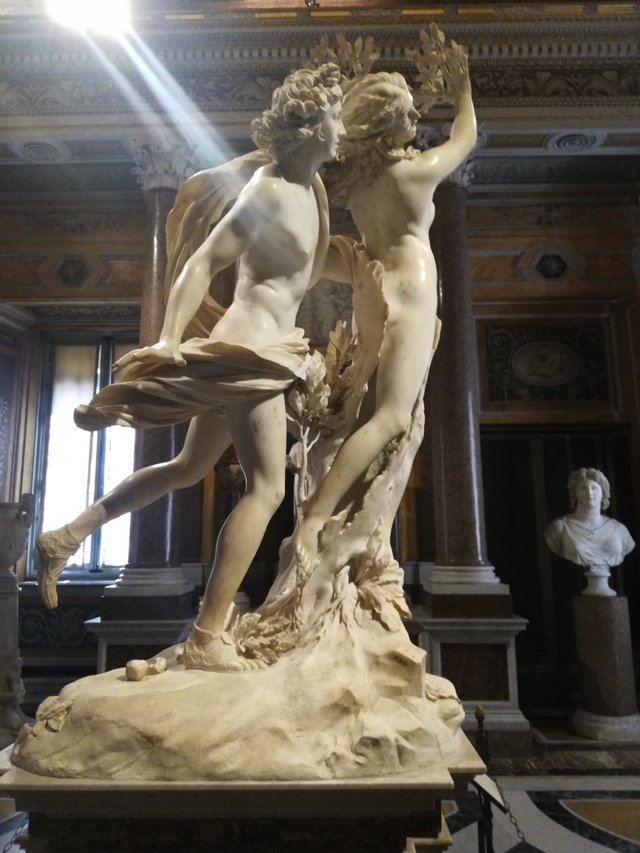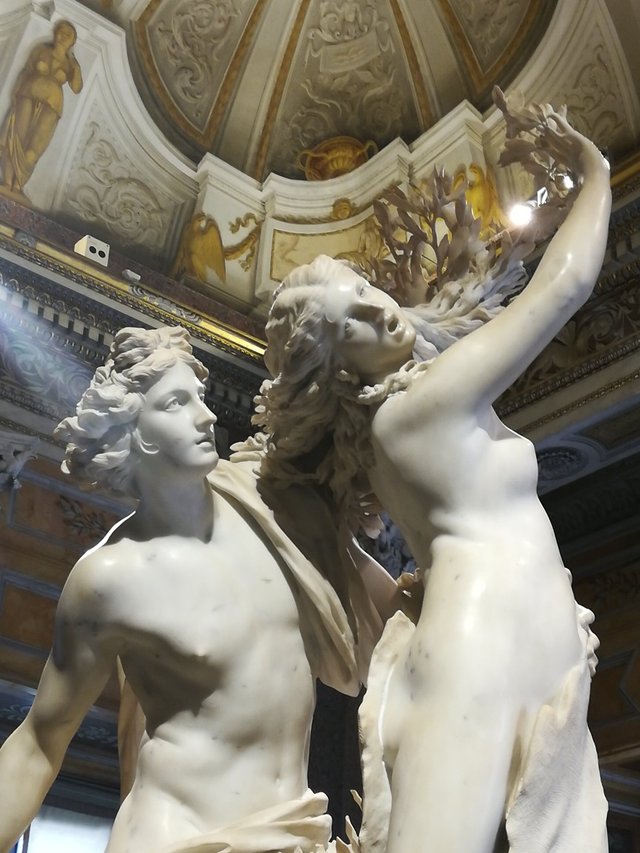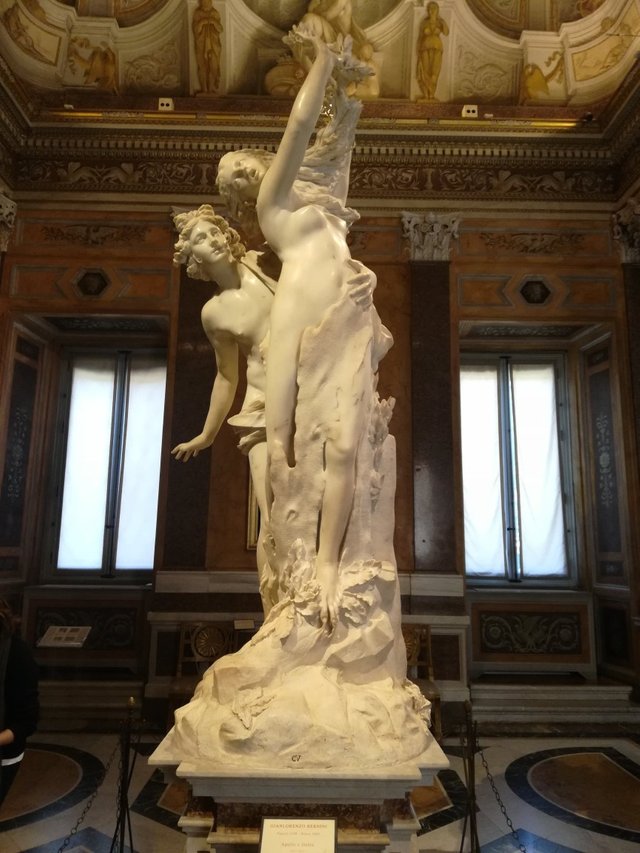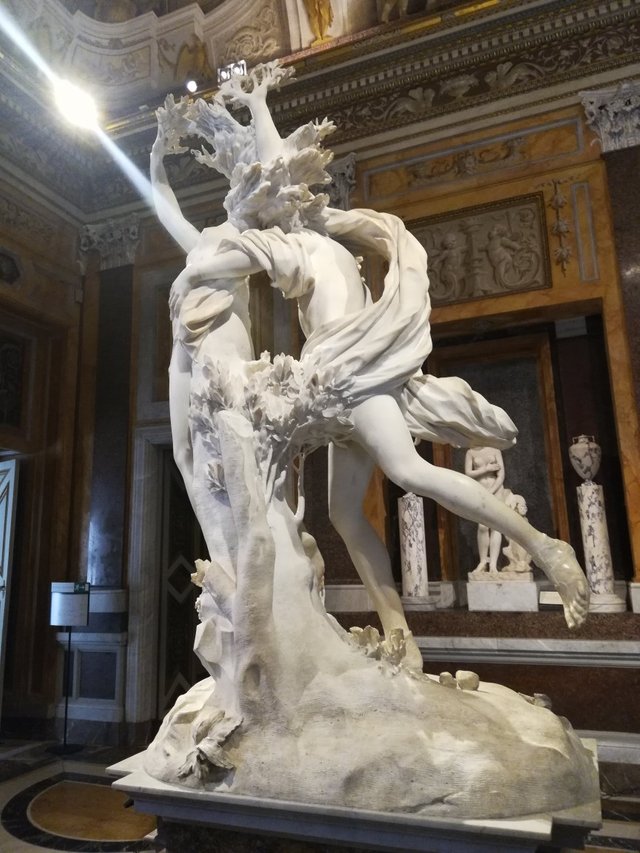Apollo and Daphne, marble in the wind of History /// Apollo e Dafne, il marmo nel vento della Storia.

Apollo and Daphne

1622-1625 Gian Lorenzo Bernini
.jpg)
Apollo and Daphne, marble in the wind of history.
The historical period.
In 1600 in Rome, the popes and cardinals increased the commissions of works of art.
In the eternal city, a cultural and artistic development grows, later called Barocco, which starts off against a Protestant Reformation that rages violently against the Papacy and its amoral behavior.
Northern Europe becomes Lutheran, the Catholic Church reacts with the interminable Council of Trent (1545-1563) creating the new conditions for bringing the faithful closer to the Catholic religion.
With Martin Luther and his written complaint against the papacy on the sale of Indulgences, the second religious block of Europe opens, Protestantism.

Martin Luther’s Disputatio pro declaratione virtutis indulgentiarum of 1517
Coping with the loss of religious consensus and this rampant phenomenon of the new Lutheran Church was the first objective of the Catholic Counter-Reformation.
Martin Luther's 95 theses in English
Figurative arts and architecture become an important part of the Papal Restoration.
They take on the value of propaganda of the values of Catholicism and the new vigor of the popes.
The objectives are: to arouse wonder and amazement in the faithful, approaching them with works of art of extraordinary scenographic and technical effects.
In parallel, the holy Inquisition is established to combat paganism and sinners.
Two very different programmatic lines.
Art and repression went hand in hand for at least 100 years.

piazza San Pietro and the Bernini colonnade.
We are in the Baroque period, when in 16 the cardinal Scipione Caffarelli Borghese commissioned this sculptural work, Gian Lorenzo Bernini, Neapolitan artist, was just 24 years old.
To complete the sculpture he spent 4 years, having to finish another sculpture, the David for Cardinal Peretti.
Now this marvel is preserved in the Borghese Gallery, an ancient Villa in the Pincio park, in Rome, transformed into a museum, which contains many works from the Baroque period and some immense masterpieces by Bernini, Caravaggio and Tiziano.
The artwork and the protagonists.

This intriguing and sad story is told by Publio Ovidio Nasone, famous Latin poet, in his Metamorphoses in the first century after Christ.
The interpretation and meaning of the myth is universally recognized as the eternal struggle of man, between chastity (Daphne) and sexual desire (Apollo)
Apollo, son of Zeus and Leto, one of the greatest gods of Olympus, god of the sun, divination and all the arts, also famous for his laurel wreath.
Daphne, a delightful nymph, daughter of Gea (the Earth) and of Peneus (the river).
He loved to walk and hunt carefree in the woods being the follower of the hunting goddess Diana.
The quiet life of Daphne was upset by a quarrel between Apollo and Eros.
The marble and the prodigy of Bernini's technique.
Only the famous Pietà by Michelangelo recalls a similar sculptural skill in rendering marble alive, arousing wonder and awe at the sight.
Bernini, a young versatile artist, wants the challenge with the subject.
A single block of marble, more than two meters high, in which he performs the greatest miracle of technical ability in the history of art.
Marble, a fragile element, Bernini leads him to become flesh and nature, body and soul, expressed in an incredible balance, reaching the maximum of the expressive possibilities of the material.
Bay leaves have a thickness of a few millimeters, so thin, that they can be broken with the fingers, like a biscuit.
.jpg)
A marble group without equal in the history of sculptural technique, torsions and dynamism carved in marble.
The protagonists, overcome the force of gravity, in the only point of support
of Apollo's foot, part of the bark of the laurel tree in which poor Dafne is transforming.
The whole marble group is projected upwards, and our gaze runs and lingers on the tragedy of the transformation of Daphne's fingers into leaves.
Through dozens and different points of view, we can admire the movement, almost a tragic dance.
Bernini had thought of all the possible views of the spectator, from the bottom, side, top, a global and at the same time detailed view of the tragic story.
The suspension in the air, of the two figures is unique in the world, light and dancing, they free themselves in space, like the troublesome thoughts of man.
Marble becomes life!
The delicate leaflets of laurel, with the terror in the eyes of Daphne, enhance its drama.
The technical expertise of Bernini is exalted in giving the skin of naked bodies the silkiness.
An exciting contrast with the rough surface of the bark of the laurel tree, which is forming, with scientific cruelty in Daphne's flesh.

I love this sculpture, for me it represents the synthesis of the Baroque, where the harsh rules of the Catholic Church are implemented with a brilliant pagan idea of the struggle between sex and chastity.
Bernini, leaves everything in suspension, in time and space, as if to testify that the vices of humanity will never be regulated, free as the wind and remembered in the visual memory by the Arts, of which Apollo will be the God,
Forever human.
The story, in Ovid's version.
Apollo, after killing the monstrous Python snake, boasted of the enterprise with Cupid, god of love.
Both archers, but Apollo taunts Cupid telling him that his bow is unused and instead he courageously killed the snake-dragon Python with a thousand arrows.
Cupid, indignant and jealous, organizes his revenge.
Prepare two arrows, one in gold, to make one fall in love, and one in lead, to make love escape.
He shot the golden arrow hitting apollo and the lead arrow hitting Daphne.
The result was a continuous torment for human beings, loving or fleeing from love.
Apollo saw Daphne, a beautiful girl and immediately fell in love with her.
Daphne, engaged in the hunt, when she saw Apollo she became frightened and began to flee.
The race began, but soon, exhausted, Daphne was joined by the young god near the river Pereo, father of the nymph.
She desperate, invoked him and Pereo turned her into a laurel plant.
.jpg)
Apollo, astonished, could not believe in the loss, and decided to make the laurel plant an evergreen, tearing off a twig and girdling with it, his head, his quiver and his zither.
Laurel will become the eternal symbol of the Arts and of victory, as a triumphal crown.
A light embrace, like marble.
Armando
I thank my friend @sciack for the photographs and his sensitivity for art.


Interpretations of Apollo and Daphne by great artists of history.

Apollo and Daphne oil painting

Etienne Liotard - Apollo and Daphne - pastel on paper
Apollo e Dafne il marmo nel vento della storia.
Il periodo storico.
Nel 1600 a Roma, i papi e i cardinali incrementano le commissioni di opere d'arte.
Nella città eterna, cresce uno sviluppo culturale e artistico, poi denominato Barocco, che prende le mosse per contrastare una Riforma Protestante che si scaglia violentemente contro il Papato e le sue condotte amorali.
Il nord europa diventa Luterano, la chiesa cattolica reagisce con l'interminabile Concilio di Trento (1545-1563) creando i nuovi presupposti per avvicinare nuovamente i fedeli al religione cattolica.
le 95 Tesi di Martin Lutero in Pdf
Con Martin Lutero e la sua denuncia scritta contro il papato sulla vendita delle Indulgenze, si apre il secondo blocco religioso d'Europa, il Protestantesimo.
Fronteggiare la perdita di consensi religiosi e questo fenomeno dilagante della nuova Chiesa Luterana era il primo obiettivo della Controriforma Cattolica.

Martin Luther’s Disputatio pro declaratione virtutis indulgentiarum of 1517
Le arti figurative e l'architettura diventano parte importante della Restaurazione papale.
Assumono il valore di propaganda dei valori del Cattolicesimo e del nuovo vigore dei papi.
Gli obiettivi sono: suscitare meraviglia e stupore nei fedeli, avvicinandoli con opere d'arte di straordinari effetti scenografici e tecnici.
Parallelamente viene instaurata la santa Inquisizione, per combattere il paganesimo e i peccatori.
Due linee programmatiche molto diverse tra loro.
Arte e repressione avanzarono di pari passo per almeno 100 anni.

piazza San Pietro and the Bernini colonnade.
Siamo nel periodo Barocco, quando nel 1622 il cardinale Scipione Caffarelli Borghese commissiona quest'opera scultorea, Gian Lorenzo Bernini, artista napoletano, aveva appena 24 anni.
Per completare la scultura egli impiegò 4 anni, dovendo terminare un'altra scultura, il David per il cardinale Peretti.
Ora questa meraviglia è conservata nella Galleria Borghese una antica Villa nel parco del Pincio, a Roma, trasformata in un museo, che raccoglie molte opere del periodo Barocco ed alcuni immensi capolavori di Bernini, Caravaggio e Tiziano.
L'opera e i protagonisti.
.jpg)
.jpg)
Questa storia intrigante e triste, viene raccontata da Publio Ovidio Nasone, celebre poeta Latino, nelle sue Metamorfosi nel I secolo dopo Cristo.
L'interpretazione ed il significato del mito è riconosciuto universalmente come l'eterna lotta dell'uomo, tra la castità (Dafne) e il desiderio sessuale (Apollo)
Apollo, figlio di Zeus e di Leto, uno dei massimi dei dell'Olimpo, dio del Sole, della divinazione e di tutte le Arti, famoso anche per la sua corona di alloro che celebra la Vittoria.
Dafne, una deliziosa ninfa, figlia di Gea (la Terra) e di Peneo (il fiume).
Amava passeggiare e cacciare spensieratamente nei boschi essendo seguace di Diana la dea della caccia.
La vita tranquilla di Dafne venne sconvolta da un litigio tra Apollo e Cupido.
Il marmo e il prodigio della tecnica di Bernini.
Solo la celebre Pietà di Michelangelo, ricorda una simile abilità scultorea, nel rendere il marmo vivo, suscitando meraviglia e stupore alla vista.
Bernini, giovane artista poliedrico, vuole la sfida con la materia.
.jpg)
Un unico blocco di marmo, alto più di due metri, nel quale compie il più grande miracolo di abilità tecnica nella storia dell'arte.
Il marmo, elemento fragile, Bernini lo porta a diventare carne e natura, corpo e anima, espressi in un equilibrio incredibile, raggiungendo il massimo delle possibilità espressive della materia.
Le foglie di alloro, hanno spessori di pochi millimetri, così sottili, che si possono spezzare con le dita, come un biscotto.
.jpg)
Un gruppo marmoreo senza uguali nella storia della tecnica scultorea, torsioni e dinamismo scolpite nel marmo .
I protagonisti, superano la forza di gravità, nell'unico punto di appoggio
del piede di Apollo, parte la corteccia dell'albero di alloro in cui si sta trasformando la povera Dafne.
Tutto il gruppo marmoreo è come proiettato verso l'alto, e il nostro sguardo corre e si sofferma sulla tragicità della trasformazione delle dita di Dafne in foglie.
Attraverso decine e differenti punti di vista, possiamo ammirarne il movimento, quasi una danza tragica.
Bernini aveva pensato a tutte le possibili viste dello spettatore, dal basso, di lato, in alto, una visione globale e al tempo stesso dettagliata della storia tragica.
La sospensione nell'aria, delle due figure è unica al mondo, leggere e danzanti, si liberano nello spazio, come i pensieri molesti dell'uomo.
Il marmo diventa vita!
Le delicate foglioline di alloro, con il terrore negli occhi di Dafne, ne esaltano il dramma.
La perizia tecnica di Bernini, si esalta nel dare alla pelle dei corpi nudi la sericità.
Un contrasto esaltante con la ruvida superficie della corteccia dell'albero di alloro, che si va formando, con crudeltà scientifica nella carne di Dafne.
Adoro questa scultura, per me rappresenta la sintesi del Barocco, dove le regole dure della chiesa cattolica, vengono messe in atto con una geniale idea pagana della lotta tra il sesso e la castità.
Bernini, lascia ogni cosa in sospensione, nel tempo e nello spazio, quasi a testimoniare che i vizi dell'umanità non saranno mai regolamentati, liberi come il vento e ricordati nella memoria visiva dalle Arti, di cui Apollo ne sarà il Dio,
Per sempre umani.

La storia, nella versione di Ovidio.
Apollo, dopo aver ucciso il mostruoso serpente Pitone, andò a vantarsi dell'impresa con Cupido, dio dell'amore.
Entrambi arcieri, ma Apollo schernisce Cupido dicendogli che il suo arco è inutilizzati e invece lui con coraggio, aveva ucciso con mille frecce il serpente-drago Pitone.
Cupido, indignato e geloso, organizza la sua vendetta.
Prepara due frecce, una in oro, per far innamorare, e una in piombo, per far sfuggire all'amore.
Scoccò la freccia d'oro colpendo apollo e la freccia in piombo colpendo Dafne.
Il risultato fu un tormento continuo per gli esseri umani, amare o fuggire dall'amore.
Apollo, vide Dafne, bellissima fanciulla e se ne innamorò immediatamente.
Dafne, impegnata nella caccia, quando vide Apollo si spaventò e iniziò a fuggire.
Iniziò la corsa, ma ben presto, esausta, Dafne venne raggiunta dal giovane dio nei pressi del fiume Pereo padre della ninfa.
Lei disperata, lo invocò e Pereo la trasformò in pianta di alloro.
.jpg)
Apollo, stupito, non riusciva a credere nella perdita, e decise di rendere la pianta di alloro un sempreverde, strappandone un rametto e cingendosi con esso, la sua testa, la sua faretra e la sua cetra.
L' Alloro diventerà il simbolo eterno delle Arti e della vittoria, come corona trionfale.
Un abbraccio leggero, come il marmo.
Armando
Ringrazio il mio amico @sciack per le fotografie e la sua sensibilità per l'arte.

Interpretations of Apollo and Daphne by great artists of history.

Apollo and Daphne oil painting

Etienne Liotard - Apollo and Daphne - pastel on paper



- Art teacher
- Curator of cultural activities
- Artistic director and President of the Cultural Association "I Colori della Vita"
https://www.icoloridellavita.life/



Grande @armandosodano, é stato un piacere!
grazie a te per le foto e per la tua passione!
Bravo bravissimo @sciack!
Posted using Partiko Android
Che bella lezione d'Arte, grazie Armando!
grazie a te per l'impegno a leggere sto papiello!
Una meraviglia per gli occhi e per la mente questo post! Grazie Armando!
Posted using Partiko Android
grazie mille Paolina.
Spettacolare anche come Cicerone, grandissimo Armando, e complimenti pure al nostro @sciack!!!
Posted using Partiko Android
Grazie Marco, è stato facile, con un aiuto di sciack!
Questo post è stato condiviso e votato dal team di curatori di discovery-it.
ty friends!
Bellissime le foto di @sciack e complimenti ad @armandosodano per il suo bellissimo post!
Posted using Partiko iOS
grazie mille @clamon
This post was shared in the Curation Collective Discord community for curators, and upvoted and resteemed by the @c-squared community account after manual review.
@c-squared runs a community witness. Please consider using one of your witness votes on us here